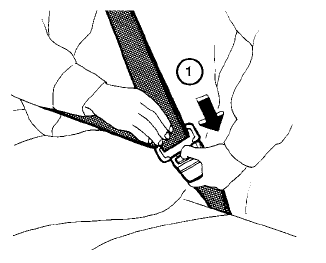Nissan Murano: Tire pressure / Tire inflation pressure
Check the tire pressures (including the spare) often and always prior to long distance trips. The recommended tire pressure specifications are shown on the F.M.V.S.S./C.M.V.S.S. certification label or the Tire and Loading Information label under the “Cold Tire Pressure” heading. The Tire and Loading Information label is affixed to the driver side center pillar. Tire pressures should be checked regularly because:
- Most tires naturally lose air over time.
- Tires can lose air suddenly when driven over potholes or other objects or if the vehicle strikes a curb while parking.
The tire pressures should be checked when the tires are cold. The tires are considered COLD after the vehicle has been parked for 3 or more hours, or driven less than 1 mile (1.6 km) at moderate speeds.
The TPMS with Easy-Fill Tire Alert provides visual and audible signals outside the vehicle for inflating tires to the recommended COLD tire pressure. For additional information, refer to “TPMS with Easy-Fill Tire Alert” in the “Starting and driving” section of this manual.
Incorrect tire pressure, including under inflation, may adversely affect tire life and vehicle handling.
WARNING
- Improperly inflated tires can fail suddenly and cause an accident.
- The GrossVehicleWeight Rating (GVWR) is located on the F.M.V.S.S./C.M.V.S.S. certification label. The vehicle weight capacity is indicated on the Tire and Loading Information label. Do not load your vehicle beyond this capacity. Overloading your vehicle may result in reduced tire life, unsafe operating conditions due to premature tire failure, or unfavorable handling characteristics and could also lead to a serious accident. Loading beyond the specified capacity may also result in failure of other vehicle components.
- Before taking a long trip, or whenever you heavily load your vehicle, use a tire pressure gauge to ensure that the tire pressures are at the specified level.
- For additional information regarding tires, refer to “Important Tire Safety Information” (US) or “Tire Safety Information” (Canada) in the Warranty Information Booklet.
 Tire Pressure Monitoring System (TPMS)
Tire Pressure Monitoring System (TPMS)
WARNING
Radio waves could adversely affect
electric medical equipment.
Those who use a pacemaker
should contact the electric medical
equipment manufacturer for
the possible influences before
use...
 Tire and Loading Information label
Tire and Loading Information label
Seating capacity: The maximum
number of occupants that can
be seated in the vehicle.
Tire size - refer to “Tire
labeling” in
this section.
Cold tire pressure: Inflate the
tires to this pressure when the
tires are cold...
Other information:
Nissan Murano (Z52) 2015-2024 Service Manual: Door Does Not Lock/unlock with Door Request Switch and Intelligent Key
Diagnosis Procedure All doors do not lock/unlock using door request switch or back door does not open using back door opener request switch or Intelligent Key button.SYMPTOM TABLE (BOTH INTELLIGENT KEYS HAVE THE SAME SYMPTOMS) Door lock operation (remote keyless entry) Door lock operation (request switch) or back door open operation (opener switch of back door panel) Engine started with ignition switch operation (registered Intelligent Key is within the detection area of inside key antenna) Engine started with ignition switch operation (registered Intelligent Key placed next to ignition switch) NG NG OK OK DIAGNOSIS PROCEDURERefer to Diagnosis Procedure...
Nissan Murano (Z52) 2015-2024 Service Manual: P0966 Pressure Control Solenoid B
DTC Description DTC DETECTION LOGIC DTC CONSULT screen terms (Trouble diagnosis content) DTC detection condition P0966 PC SOLENOID B (Pressure Control Solenoid B Control Circuit Low) Diagnosis condition TCM power supply voltage: More than 11 V Signal — Threshold TCM judges that solenoid valve circuit is shorted to ground Diagnosis delay time Maintained for 1 second POSSIBLE CAUSE Harness or connector (Primary pressure solenoid valve circuit shorted to ground) Primary pressure solenoid valve FAIL-SAFE Selector shock is large Start is slow Acceleration is slow Lock-up is not performed DTC Confirmation Procedure PREPARATION BEFORE WORK If another "DTC CONFIRMATION PROCEDURE" occurs just before, turn ignition switch OFF and wait for at least 10 seconds, then perform the next test...
Categories
- Manuals Home
- Nissan Murano Owners Manual
- Nissan Murano Service Manual
- Jacking up vehicle and removing the damaged tire
- Intelligent Forward Collision Warning (I-FCW)
- Checking engine oil level
- New on site
- Most important about car
Unfastening the seat belts. Checking seat belt operation
Unfastening the seat belts

To unfasten the seat belt, press the button
on the buckle  . The seat belt
automatically
retracts.
. The seat belt
automatically
retracts.
